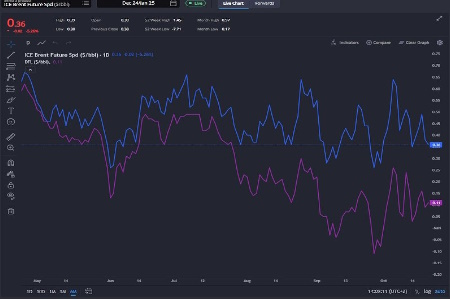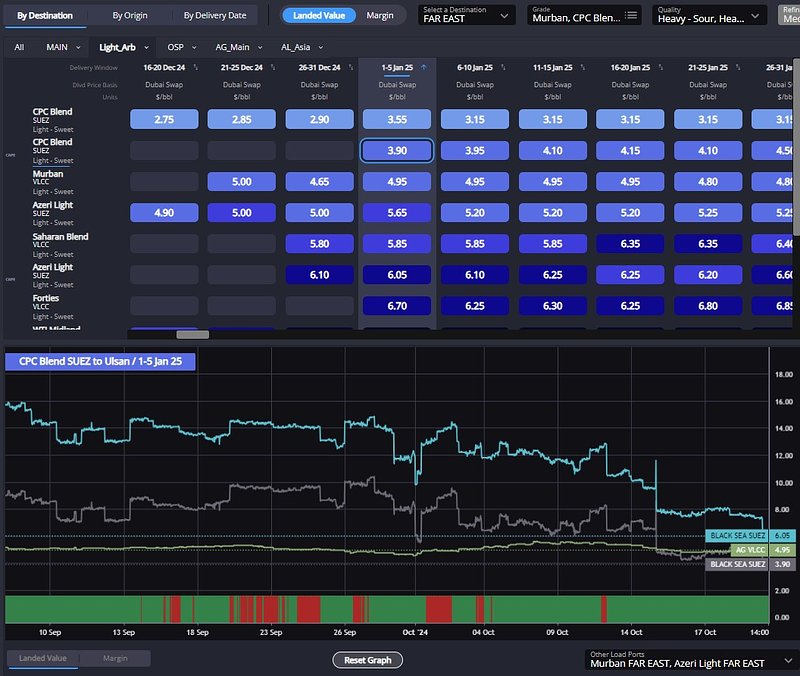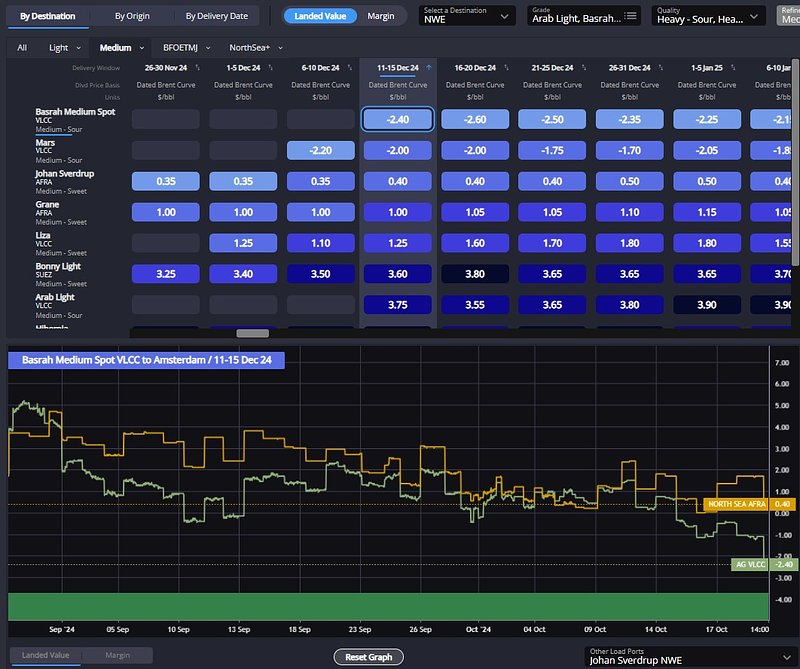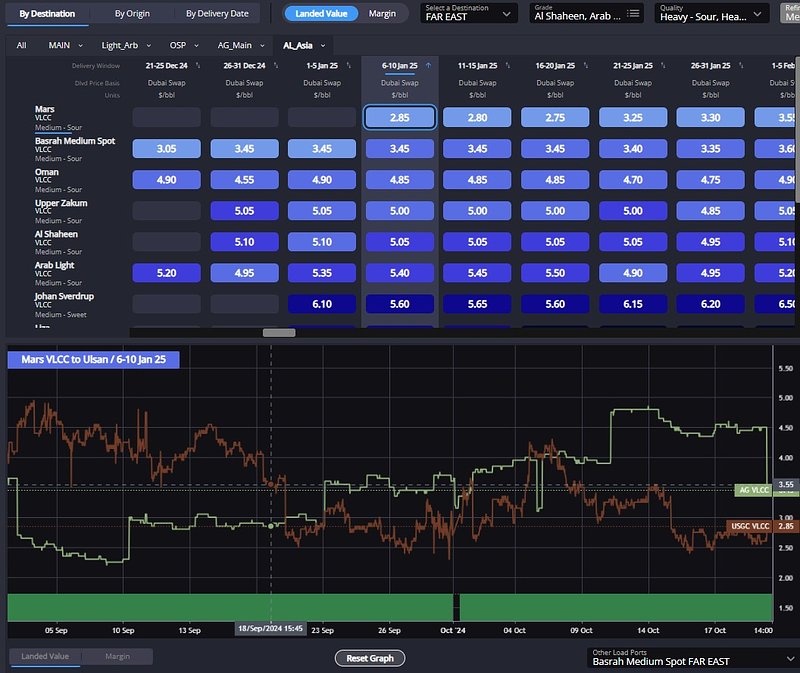Weak European Market Is Now Pricing Crude To Leave The Region
Commentary summary:
- WTI now priced out of Europe where a glut of light sweet has emerged.
- The weakening in physical Brent (CFDs) and freefall in Med premia should see some light sweets clear to Asia (expect pressure there).
- The combination of Med clearing and marginal WTI pricing out of Europe sets up a rebound in physical premia, at least for a short while.
Flat price continues to weaken while the physical crude market, in particular Europe, remains on a downward spiral. In Europe, the Med/Black Sea is in free-fall with Es Sider down $1.55 d-o-d on Friday. Further declines in Azeri & BTC bring the total drop in their FOBs to nearly $4/bbl over the last two weeks.
This means plenty pressure in NWE, where Azeri, CPC and Es Sider are still arbing effectively vs Forties.
Demand indications in Europe and Asia are not fantastic even though we are coming out of the maintenance season. On the back of this, we remain bearish crude time-spreads short-term.
However, there are a few trends coming together that could see at least temporary correction in physical premia once this glut begins to clear a little.

Firstly a note on products vs runs: August JODI data show an interesting nuance here. European runs were undoubtedly low, possibly lower than anticipated even assuming run cuts.
This drew product stocks nicely with more draws likely in Sep/Oct, mirroring the current low product stock situation in the US. Cracks/margins might be a bit more sensitive to supply chain issues or demand strength (e.g. wintry weather) than we might have thought a few weeks ago.
There are two things to note on the crude side. The first is that with trans-Atlantic freight actually picking up again, WTI remains expensive in NWE. Even VLCCs are landing on par with Forties for early December.

We presume this won’t last for all that long. Presumably crude stocks in the US will be allowed to build to a point where Nymex spreads can preferentially weaken, with arbs to Asia also still closed.
Paper TI/Brent should widen if this is to happen and/or if WTI is to price back into Europe.
For now, marginal WTI flows into Europe will be squeezed and potentially leave Europe shorter than anticipated, or at least shorter than current physical pricing suggests.

The weakening of the Med (other than helping to price out WTI from NWE) has also made the arb eastward more attractive.
CPC has already been arbing to Far East, but Azeri is also moving closer to open while Sarahan Blend is becoming more attractive. It could be that physical premia in Europe start to rebound if the market begins to clear Med/Black Sea barrels more substantially and in the absence of marginal WTI.

On medium grades, spot Basrah has come under a lot of pressure into Europe and has priced out JS entirely, which itself has seen FOB premia rise after clearing barrels to Asia (JS now looks closed to East, so FOB premia might have to come off soon).
In Asia, the start of trade cycle points to a lacklustre market for now; FOB premia out of MEG have gently declined over the last week or so.
Murban doesn’t look like it needs to come under pressure just yet, though arbs from the west are improved. We note WTI VLCC cracking margins into Far East are verging on positive again, however we would still class WTI econs as closed.
On medium crude, spot Basrah Medium in Asia appears to be responding to pressure from Mars (and earlier in the month from JS). Oman and UZ look expensive on this basis and may be ripe for some downside given weak demand indications. Tupi is for now priced out of Asia, while Mars remains cheap.

Chinese demand itself appears sluggish, and the non-approval of new export quotas adds to the bearish outlook for crude imports going forward. The Yulong start-up is also not likely to prove a net addition to Chinese runs as these are driven top-down by crude import quotas and product export quotas.
Please let me know if this content is of use to you, and I would be happy to explore opportunities for further collaboration.
About the Author
Neil Crosby is an experienced energy market and commodity analyst, specialising in crude oil, oil products, biofuels, and carbon. With roles at OilX and JBC Energy, he has extensive expertise in global oil industry analysis, forecasting tools, bespoke research, and client communication. His focus on refining and petrochemicals underscores his specialisation.
About Sparta
Founded in 2020, Sparta made waves in the commodity analytics space in March 2022 when it secured a $6m series A investment from Singular. This success then later snowballed into a further $17.5M in a series A funding round led by the technology venture capital firm FirstMark, with participation from existing shareholder, Singular.
The platform, created by former traders Miles Moseley and Felipe Elink Schuurman, is designed to answer a common problem shared by most traders: 90% of pricing data required to make trading decisions is kept in silos and shared manually by voice, email, or chat.
Sparta breaks these existing data silos and combines the physical and paper markets to provide traders with live access to global raw prices, from futures and swaps to forward freight and physical premiums. We work with clients globally, including Philips 66, Chevron, Trafigura, Equinor and more.
Source: Sparta
